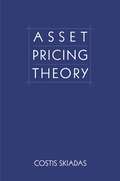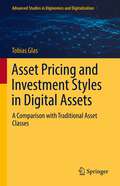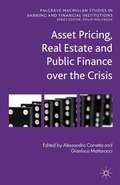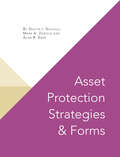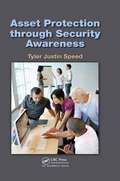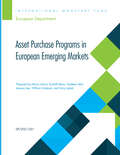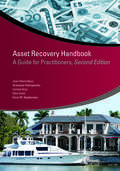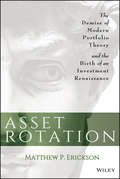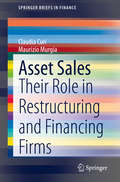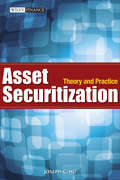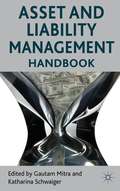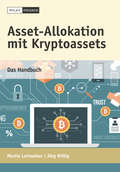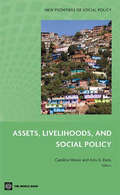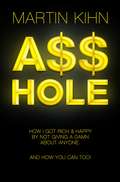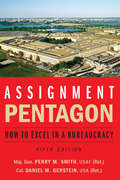- Table View
- List View
Asset Pricing For Dynamic Economies
by Sumru Altug Pamela LabadieThis 2008 introduction to general equilibrium modelling takes an integrated approach to the analysis of macroeconomics and finance. It provides students, practitioners, and policymakers with an easily accessible set of tools that can be used to analyze a wide range of economic phenomena. Key features: • Provides a consistent framework for understanding dynamic economic models • Introduces key concepts in finance in a discrete time setting • Develops simple recursive approach for analyzing a variety of problems in a dynamic, stochastic environment • Sequentially builds up the analysis of consumption, production, and investment models to study their implications for allocations and asset prices • Reviews business cycle analysis and the business cycle implications of monetary and international models • Covers latest research on asset pricing in overlapping generations models and on models with borrowing constraints and transaction costs • Includes end-of-chapter exercises allowing readers to monitor their understanding of each topic Online resources are available at www. cambridge. org/altug_labadie
Asset Pricing Theory (Princeton Series in Finance)
by Costis SkiadasAsset Pricing Theory is an advanced textbook for doctoral students and researchers that offers a modern introduction to the theoretical and methodological foundations of competitive asset pricing. Costis Skiadas develops in depth the fundamentals of arbitrage pricing, mean-variance analysis, equilibrium pricing, and optimal consumption/portfolio choice in discrete settings, but with emphasis on geometric and martingale methods that facilitate an effortless transition to the more advanced continuous-time theory. Among the book's many innovations are its use of recursive utility as the benchmark representation of dynamic preferences, and an associated theory of equilibrium pricing and optimal portfolio choice that goes beyond the existing literature. Asset Pricing Theory is complete with extensive exercises at the end of every chapter and comprehensive mathematical appendixes, making this book a self-contained resource for graduate students and academic researchers, as well as mathematically sophisticated practitioners seeking a deeper understanding of concepts and methods on which practical models are built. Covers in depth the modern theoretical foundations of competitive asset pricing and consumption/portfolio choice Uses recursive utility as the benchmark preference representation in dynamic settings Sets the foundations for advanced modeling using geometric arguments and martingale methodology Features self-contained mathematical appendixes Includes extensive end-of-chapter exercises
Asset Pricing and Investment Styles in Digital Assets: A Comparison with Traditional Asset Classes (Advanced Studies in Diginomics and Digitalization)
by Tobias GlasThis book analyzes the emerging asset class of digital assets. When a new asset class originates, researchers try to understand some basic questions: Can digital assets, with the flagship asset bitcoin, really be considered a serious asset class? Since it is possible to trade digital assets, does it make sense to trade or to invest in these assets? How do digital assets compare to traditional asset classes like equities or bonds? After describing basic financial theory and breaking down the digital asset universe, this book provides fundamental knowledge with respect to this young and rising asset class. It focuses on special issues like the application of technical indicators, investment styles, asset pricing and portfolio construction. Furthermore, it offers remarks and links to other traditional asset classes and describes and warns of data issues in digital asset data.
Asset Pricing, Real Estate and Public Finance over the Crisis
by Alessandro Carretta Gianluca MattarocciThe current financial crisis started from the US real estate market and after, though the increase of risk premium requested by investors and due to the lack of liquidity of all financial markets, it became a world financial crisis. A detailed analysis during the crisis focuses attention on asset management, the real estate and public sector.
Asset Protection Strategies & Forms
by Mark A. Ziebold Dustin I. Nichols Alan R. EberThe living trust has become almost mandatory in estate planning, but it is frequently offered without any thought to safeguarding the inheritance. However, children's inheritances in a living trust can be readily protected from creditors if it is made discretionary or includes shifting language. Asset Protection Strategies & Forms is a complete planning toolbox that provides you with a full range of domestic and international structures for safeguarding assets, from simple spendthrift trusts through equity strips to collapsing bridges. Structures are diagrammed and explained, with supporting law, tax considerations, case studies, and pattern clauses, making them easy to follow and explain. In addition to comprehensive explanations of the various asset protection options, this book offers over 90 forms, helping you do everything you need to protect your clients' assets, from basic client intake to avoid common problems, to setting up sophisticated international trusts for the highest protection. The living trust has become almost mandatory in estate planning, but it is frequently offered without any thought to safeguarding the inheritance. However, children's inheritances in a living trust can be readily protected from creditors if it is made discretionary or includes shifting language. Asset Protection Strategies & Forms is a complete planning toolbox that provides you with a full range of domestic and international structures for safeguarding assets, from simple spendthrift trusts through equity strips to collapsing bridges. Structures are diagrammed and explained, with supporting law, tax considerations, case studies, and pattern clauses, making them easy to follow and explain. In addition to comprehensive explanations of the various asset protection options, this book offers over 90 forms, helping you do everything you need to protect your clients' assets, from basic client intake to avoid common problems, to setting up sophisticated international trusts for the highest protection.
Asset Protection through Security Awareness: Theory, Methods, And Applications (Systems Innovation Book Ser.)
by Tyler Justin SpeedSupplying a high-level overview of how to protect your company's physical and intangible assets, Asset Protection through Security Awareness explains the best ways to enlist the assistance of your employees as the first line of defense in safeguarding company assets and mitigating security risks. The author reviews key topics surrounding computer s
Asset Purchase Programs in European Emerging Markets (Departmental Papers)
by Marco Arena, Rudolfs Bems, Nadeem Ilahi, Jaewoo Lee, William Lindquist, and Tonny LybekA report from the International Monetary Fund.
Asset Recovery Handbook
by Larissa Gray Clive Scott Kevin Stephenson Jean-Pierre BrunDeveloping countries lose an estimated US$20-40 billion each year through bribery, misappropriation of funds, and other corrupt practices. Much of the proceeds of this corruption find 'safe haven' in the world's financial centers. These criminal flows are a drain on social services and economic development programs, contributing to the impoverishment of the world's poorest countries. Many developing countries have already sought to recover stolen assets. A number of successful high-profile cases with creative international cooperation have demonstrated that asset recovery is possible. However, it is highly complex, involving coordination and collaboration with domestic agencies and ministries in multiple jurisdictions, as well as the capacity to trace and secure assets and pursue various legal options-whether criminal confiscation, non-conviction based confiscation, civil actions, or other alternatives. This process can be overwhelming for even the most experienced of practitioners. It is exceptionally difficult for those working in the context of failed states, widespread corruption, or limited resources. With this in mind, the Stolen Asset Recovery (StAR) Initiative has developed the Asset Recovery Handbook: A Guide for Practitioners to guide those grappling with the strategic, organizational, investigative, and legal challenges of recovering stolen assets. A practitioner-led project, the Handbook provides common approaches to recovering stolen assets located in foreign jurisdictions, identifies the challenges that practitioners are likely to encounter, and introduces good practices. Included are examples of tools that can be used by practitioners, such as sample intelligence reports, applications for court orders, and mutual legal assistance requests.
Asset Recovery Handbook: A Guide for Practitioners, Second Edition (StAR Initiative)
by Scott Larissa Gray Jean-Pierre Brun Anastasia SotiropoulouDeveloping countries lose billions each year through bribery, misappropriation of funds, and other corrupt practices. Much of the proceeds of this corruption find 'safe haven' in the world's financial centers. These criminal flows are a drain on social services and economic development programs, contributing to the impoverishment of the world's poorest countries. Many developing countries have already sought to recover stolen assets. A number of successful high-profile cases with creative international cooperation has demonstrated that asset recovery is possible. However, it is highly complex, involving coordination and collaboration with domestic agencies and ministries in multiple jurisdictions, as well as the capacity to trace and secure assets and pursue various legal options—whether criminal confiscation, non-conviction based confiscation, civil actions, or other alternatives. This process can be overwhelming for even the most experienced practitioners. It is exceptionally difficult for those working in the context of failed states, widespread corruption, or limited resources. With this in mind, the Stolen Asset Recovery (StAR) Initiative has developed and updated this Asset Recovery Handbook: A Guide for Practitioners to assist those grappling with the strategic, organizational, investigative, and legal challenges of recovering stolen assets. A practitioner-led project, the Handbook provides common approaches to recovering stolen assets located in foreign jurisdictions, identifies the challenges that practitioners are likely to encounter, and introduces good practices. It includes examples of tools that can be used by practitioners, such as sample intelligence reports, applications for court orders, and mutual legal assistance requests. StAR—the Stolen Asset Recovery Initiative—is a partnership between the World Bank Group and the United Nations Office on Drugs and Crime that supports international efforts to end safe havens for corrupt funds. StAR works with developing countries and financial centers to prevent the laundering of the proceeds of corruption and to facilitate more systematic and timely return of stolen assets.
Asset Reporting
by Paul M. Healy Preeti ChoudharyUsing historical cost and conservatism to identify and value assets, this case explains the criteria for asset reporting in straightforward situations and then examines scenarios where implementing the criteria for recognition and valuation of assets is conceptually challenging. These more complex situations occur when: 1) Ownership or control of a resource is uncertain; 2) The economic benefits from outlays are uncertain or difficult to quantify; or 3) Resource values have changed.
Asset Rotation
by Matthew P. EricksonAn all-weather, tactical approach to asset management utilizingExchange Traded Funds (ETFs) In Asset Rotation, portfolio management pioneer MatthewP. Erickson demonstrates a time-tested approach to asset managementthat has worked throughout the history of capital markets, in goodtimes and bad. Providing investors with strong participation inrising markets, but more importantly with a discipline to reduceparticipation in prolonged declines. Over time this revolutionaryapproach has yielded superior returns, with significantly reducedlevels of risk; providing the engine for true, long-termsustainable growth.The investment world as we know it has changed, and the paradigmhas shifted. What has worked in the past may no longer work in thefuture. No longer may bonds be regarded as a safe haven assetclass, as for the first time in generations, investors in fixedincome face losses as interest rates rise from historical all-timelows. For those adhering to a conventional Modern Portfolio Theorybased investment approach to asset management, what was onceregarded as safe and stable, may very well soon become our greatestimpediment.Asset Rotation provides investors with a practicalsolution for today's real world problems. This tactical approach toasset management provides us with concrete proof that there isindeed a better way.We are standing on the precipice of an InvestmentRenaissance. What was previously impossible, is now possible.Find out how.Presents an easy-to-understand price momentum-based approach toinvestingIllustrates the benefits of asset rotationOffers a systematic approach for securing a sound financialfutureProvides further insights as to how to customize your own assetrotation portfolioMatthew Erickson gives investors a hands-on resource for how tonavigate an increasingly difficult investment landscape, byproviding them with keen insights into the most rapidly growingsegment of the investment markets.
Asset Sales: Their Role in Restructuring and Financing Firms (SpringerBriefs in Finance)
by Claudia Curi Maurizio MurgiaIn a new world characterized by more frequent and rich flows of information, with more efficient and plenty of available external capital, how will the – simultaneous – investment and divestment decisions be affected? This book thoroughly covers the main features and relevance of asset sales as an integral component of many companies’ growth strategies in the current and continually evolving corporate finance eco-system. After an introductory section on the relevance of asset sales in corporations (both non-financial and financial), it discusses the corporate asset market and the mechanisms of asset sale transactions. The focus then turns to the theory of finance in asset sales (the efficiency and financing theory) and the extensive empirical literature now available. In light of recent and rapid technological and digital advances, a concluding section presents new perspectives on analyzing asset sales transactions. Chiefly intended as a primer for PhD students and academics, the book offers roadmaps for the empirical research landscape and suggests future research directions.
Asset Securitization
by Joseph C. HuAsset Securitization is intended for beginners and market professionals alike who are interested in learning about asset securitization-its concepts and practices. It is designed so that the readers will come away with a fundamental but comprehensive understanding of the asset securitization market. As such, the book aims to provide a review of the market's development, necessary framework, potential benefits, and detailed descriptions of major asset securitization products. Part I of the book, which consists of four chapters, will discuss the fundamental concepts, the funding efficiency, the market participants, and the potential benefits of asset securitization. An analysis of mortgage finance will be provided in Part II, which consists of six chapters that cover a variety of topics from the description of many different types of residential mortgages to the securitization of different types of residential mortgages, including the now infamous sub-prime mortgages. Also included are important topics, such as prepayments, cash flow structure, maturity and credit tranching, and the trading and relative value of the various mortgage-backed securities. The three chapters in Part III will explain the other major asset securitization products, such as commercial mortgage-backed securities, credit card receivable-backed securities, auto loan-backed securities, and collateralized bond obligations. Part IV has two chapters: one reviews the collapse and the potential recovery of the asset securitization market, and the other describes the asset securitization efforts in Japan, Australia, Taiwan, and China. Extensive tables and charts are presented to help illustrate a concept or describe a product. Neither analytical discussions nor investment strategies of the various asset-backed securities are included as they are not the focus of this book.
Asset Securitization and Optimal Retention*
by John Kiff Michael KisserA report from the International Monetary Fund.
Asset and Liability Management Handbook
by Gautam Mitra Katharina SchwaigerRecent years have shown an increase in development and acceptance of quantitative methods for asset and liability management strategies. This book presents state of the art quantitative decision models for three sectors: pension funds, insurance companies and banks, taking into account new regulations and the industries risks.
Asset-Allokation mit Kryptoassets: Das Handbuch
by Martin Leinweber Jörg WilligNiedrige Zinsen und eine höhere Inflation setzen Kapitalanleger unter Handlungsdruck. Vor der Aufgabe des langfristigen Kaufkrafterhalts stehen private Anleger ebenso wie Stiftungen, Pensionskassen, Staatsfonds und Family Offices. Institutionelle Investoren wenden sich daher schon seit Jahren alternativen Anlagen wie Venture Capital oder Private Equity-Beteiligungen zu. Schrittweise wächst auch die Aufgeschlossenheit gegenüber neuen digitalen Assets. Die Informationen zu dieser Anlageklasse sind jedoch noch fragmentiert und lückenhaft. Folgerichtig zählt die Londoner "Economist Group" das mangelnde Verständnis zu den größten Hindernissen auf dem Weg zur Allokation von Kryptoassets. Praxisorientierte Darstellung aus Sicht der Investoren "Asset-Allokation für Kryptoassets" ist das erste Handbuch für die Integration digitaler Assets in Anlageportfolios. Martin Leinweber und Jörg Willig beantworten die relevanten Fragen aus der Perspektive von Investoren und lassen dabei ihre langjährige Erfahrung als institutionelle Portfolio Manager einfließen. Neben einer Darstellung der Entstehung digitaler Assets und der dahinterstehenden Motivation gehen die Autoren ausführlich auf die für Anleger wichtigen Themengebiete ein. - Taxonomie und Bewertung von Kryptoassets - Kryptoassets als eigenständige Assetklasse - Chancen und Risiken im Vergleich zu anderen Anlagen - Gegenüberstellung von Krypto-Aktien und Kryptoassets - Allokationsquoten von Kryptoassets in der Asset-Allokation - Integration digitaler Assets in bekannte Langfriststrategien - Anlagemöglichkeiten und verfügbare Instrumente - Entwicklung der Marktinfrastruktur und Dienstleister Mit "Asset-Allokation mit Kryptoassets" zeigen die Autoren, wie private und professionelle Anleger digitale Assets in ihre Portfolios integrieren können. Interviews Abgerundet wird das Buch durch Interviews mit Spezialisten und einem Geleitwort von Alexander Höptner (BitMEX). Mit den Autoren sprachen: - Patrick Karb (Hauck & Aufhäuser Innovative Capital) - Thomas Kettner (MV Index Solutions), - Max Lautenschläger (Iconic Holding) - Bernadette Leuzinger (Crypto Finance Gruppe) - Prof. Dr. Philipp Sandner (Frankfurt School Blockchain Center) - Désirée Velleuer & Reto Stiffler (Crypto Consulting, SwissRex)
Asset-Liability and Liquidity Management
by Pooya FarahvashAsset-Liability and Liquidity Management distils the author’s extensive experience in the financial industry, and ALM in particular, into concise and comprehensive lessons. Each of the topics are covered with a focus on real-world applications, based on the author’s own experience in the industry. The author is the Vice President of Treasury Modeling and Analytics at American Express. He is also an adjunct Professor at New York University, teaching a variety of analytical courses. Learn from the best as Dr. Farahvash takes you through basic and advanced topics, including: The fundamentals of analytical finance Detailed explanations of financial valuation models for a variety of products The principle of economic value of equity and value-at-risk The principle of net interest income and earnings-at-risk Liquidity risk Funds transfer pricing A detailed Appendix at the end of the book helps novice users with basic probability and statistics concepts used in financial analytics.
Assetization: Turning Things into Assets in Technoscientific Capitalism (Inside Technology)
by Kean Birch Fabian MuniesaHow the asset--anything that can be controlled, traded, and capitalized as a revenue stream--has become the primary basis of technoscientific capitalism.In this book, scholars from a range of disciplines argue that the asset--meaning anything that can be controlled, traded, and capitalized as a revenue stream--has become the primary basis of technoscientific capitalism. An asset can be an object or an experience, a sum of money or a life form, a patent or a bodily function. A process of assetization prevails, imposing investment and return as the key rationale, and overtaking commodification and its speculative logic. Although assets can be bought and sold, the point is to get a durable economic rent from them rather than make a killing on the market.
Assets - More Estimates and Assumptions (Except for Cash): Understanding the Balance Sheet-Financial Intelligence for Entrepreneurs
by Karen Berman Joe KnightThere are two kinds of assets: current and long-term. Within those broad categories, there are many line items. This chapter lists the ones that appear on nearly every company's balance sheet. This chapter is excerpted from "Financial Intelligence for Entrepreneurs: What You Really Need to Know About the Numbers."
Assets, Capabilities, and Other Resources
by Cynthia A. Montgomery Maria P. RocheIndustry and Background Note
Assets, Livelihoods, and Social Policy
by Caroline Moser Anis A. DaniGiven the lack of adequate universal social welfare for those unable to find jobs in the salaried formal sector, the livelihoods and well-being of most poor people depends heavily on their asset base. This includes their ability to access and accumulate assets, obtain decent returns from these assets, and use their asset base to manage risks. 'Assets, Livelihoods, and Social Policy' discusses the diverse strategies adopted by people in different contexts to accumulate assets through migration, housing investments, natural resources management, and informal businesses. An asset-based social policy can strengthen asset accumulation strategies as well as help the poor overcome the constraints of unfavorable institutional environments. To a considerable extent, asset accumulation strategies depend on the agency exercised by people themselves through individual or collective action. At the same time, the status of policies and institutions can enable or hinder these strategies and affect livelihood outcomes. In synthesis, the case studies lead to the differentiation among three different types of policies: - policies that affect outcomes by directly influencing access to assets by the poor-such as land, housing, natural resources, or credit. - policies and public investments that change the nature of returns on assets-such as investments in rural roads, agricultural inputs, and market development. - policies that transform the value of assets held by the poor by virtue of administrative decisions that increase or reduce value-such as re-classification of land from arable or pasture to protected lands, land use regulations affecting resource use, or modification in regulations governing labor rights or migration. The chapters, originally commissioned to re-examine major gaps in knowledge and development practice ten years after the Copenhagen Summit on Social Development, are authored by leading scholars from economics, anthropology, sociology, geography, and development studies. This book is part of a new series, New Frontiers in Social Policy, which examines issues and approaches to extend the boundaries of social policy beyond conventional social services toward policies and institutions that improve equality of opportunity and social justice in developing countries. Other titles in the series include Inclusive States: Social Policy and Structural Inequalities, and Institutional Pathways to Equity: Addressing Inequality Traps.
Assets-as-Service: Service statt Produkte – so gelingt der Einstieg in die Service-Economy (essentials)
by Uwe SeebacherDas Buch beschreibt pragmatisch und leicht verständlich das bewährte Assets-as-Service (AAS)-Prozessmodell des Autors. Das Modell besteht aus vier Schritten, die Unternehmen ohne große Investitionen und Risiken umsetzen können, um in kurzer Zeit in der Netflix-Economy profitabel zu werden und damit nachhaltige Wettbewerbsvorteile zu sichern. Darüber hinaus wird das AAS-Self-Assessment-Tool erläutert, mit dem Manager sofort die eigene Organisation hinsichtlich ihrer Readiness in Bezug auf AAS und die Abo-Ökonomie bewerten können, um zu wissen, wo sie mit welchen Maßnahmen gezielt und effektiv in der Abo-Wirtschaft ansetzen müssen.
Assets: More Estimates and Assumptions (Except for Cash)--Understanding a Balance Sheet
by John Case Karen Berman Joe KnightThis chapter lists the most common line items under different categories of assets on a balance sheet.
Asshole
by Martin KihnMartin Kihn was the nicest guy in the world - and it was killing him. But on the day he turned forty, Marty decided to change his life - for the meaner. Tired of being passed over for promotions at work, Marty set out on a journey to transform himself from Mr. Nice Guy into a rule-breaking, order-giving dickhead like the "Marty Kaan" character played by Don Cheadle in the Showtime series House of Lies, based on Kihn's book of the same name. Asshole is the story of Kihn's ascent from Beta Male to Alpha Male to Asshole. He shares the techniques that helped him hone his image as a jerk, including the essential body language (don't smile, unless others are in pain); covers typical activities (credit stealing, getting even); and delineates classic behavior patterns, including speaking loudly and interrupting often, and insisting you've never, ever made a mistake.From acting lessons to boxing lessons, from hiring a life coach to covertly observing his nemesis at work, Marty develops the Seven Principles of Assholism. But will it be enough to earn him a promotion? Or will he alienate others to the point where his own wife won't be able to stand him?
Assignment: How to Excel in a Bureaucracy (Association Of The U. S. Army Book Ser.)
by Maj. Gen. Smith Daniel M. GersteinSelected for the 2019 Commandant&’s Professional Reading List, Assignment: Pentagon takes the reader on an insider&’s tour of the Pentagon, describing how the headquarters for the world&’s largest multinational &“corporation&” functions. The reader gains insights into how this bureaucracy functions as well as the stresses and strains inherent to such a complex organization. Now in its fifth edition, Assignment: Pentagon remains the best practical guide for anyone who works for the Pentagon or any other large bureaucracy. Eminently readable, Assignment: Pentagon is the essential guide for the newly assigned military person, fresh civilian, or interested outsider to the Pentagon&’s informal set of arrangements, networks, and functions that operate in the service and joint service world. With updated information about jobs and Pentagon vernacular, this fifth edition delivers a wealth of practical advice and helpful hints about surviving the challenges of working in &“the Building.&” If you&’ve been assigned to the Pentagon or are starting work for any large company, you need to read Assignment: Pentagon.

